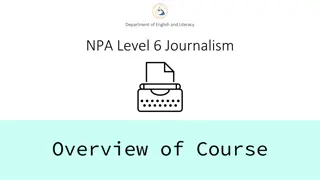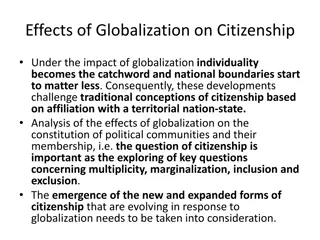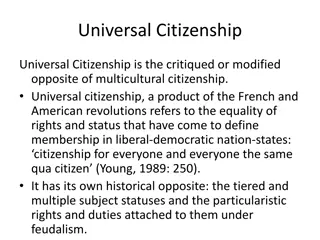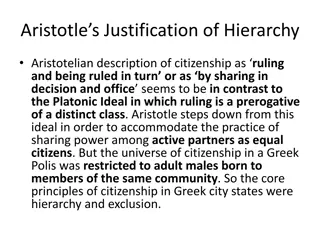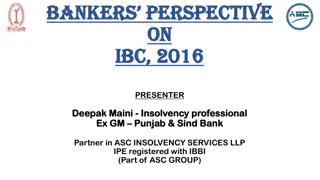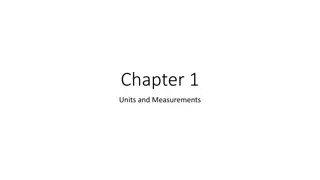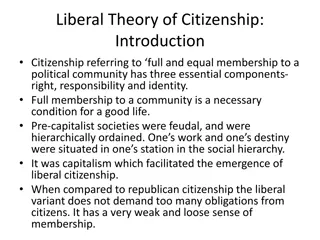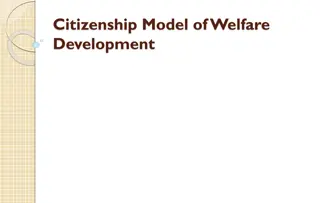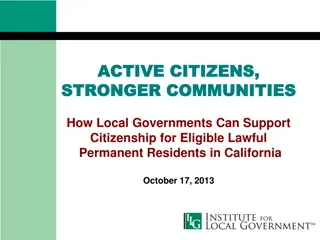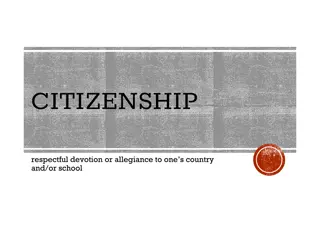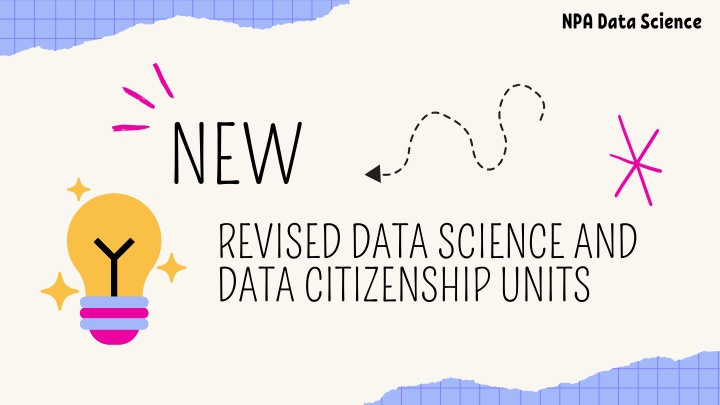
Data Science and Citizenship Units Overview
Explore the comprehensive learning outcomes of Data Science levels 4 and 5, covering topics such as reasons for development, applications, methods of analysis, and more. Dive into the fundamentals of data science and its practical applications to gain valuable insights.
Download Presentation

Please find below an Image/Link to download the presentation.
The content on the website is provided AS IS for your information and personal use only. It may not be sold, licensed, or shared on other websites without obtaining consent from the author. If you encounter any issues during the download, it is possible that the publisher has removed the file from their server.
You are allowed to download the files provided on this website for personal or commercial use, subject to the condition that they are used lawfully. All files are the property of their respective owners.
The content on the website is provided AS IS for your information and personal use only. It may not be sold, licensed, or shared on other websites without obtaining consent from the author.
E N D
Presentation Transcript
NPA Data Science NEW REVISED DATA SCIENCE AND DATA CITIZENSHIP UNITS
SQCF Level 4 Data Science
Learning Outcome 1 Data Science Level 4 DESCRIBE DATA SCIENCE. DESCRIBE DATA SCIENCE. State the reasons for the development of data science. a a Describe the applications of data science NEW OLD Describe contemporary applications of data science. b b Describe the benefits of data science Describe the steps in solving a problem using data science. c State the steps in solving a problem using data science c Identify sources of bias in data science including historical bias. d
Learning Outcome 2 Data Science Level 4 DESCRIBE SIMPLE WAYS OF ANALYSING DATA. STATE SIMPLE WAYS OF ANALYSING DATA. Describe common data types and data formats. State common data types and data formats a a b Describe structured and unstructured data. NEW OLD State simple methods of cleaning and transforming data b Describe simple methods of cleaning and transforming data. c State basic descriptive statistics used to summarise a dataset c Describe basic descriptive statistics used to summarise a dataset. d Identify types of simple data visualisations d e Describe simple data visualisations.
Learning Outcome 3 Data Science Level 4 ANALYSE SIMPLE DATA TO COMMUNICATE BASIC INSIGHTS. ANALYSE A SMALL DATASET TO IDENTIFY PATTERNS. Perform simple data cleaning and structuring. a Perform simple data cleaning and structuring a NEW OLD Perform basic analyses including sort, filter, group and summarise. b Perform basic analyses including sort, filter and summarise b c Visualise the data to provide basic insights. Visualise data to communicate basic insights c Create a simple report to communicate insights. d
SQCF Level 5 Data Science
Learning Outcome 1 Data Science Level 5 DESCRIBE DATA SCIENCE. DESCRIBE THE TOOLS AND TECHNIQUES OF DATA SCIENCE. Describe the reasons for the development and growth of data science. a Describe the applications, benefits and challenges of data science a b Describe contemporary applications of data science. NEW OLD Describe the data science life cycle including the potential for bias at each stage. c Describe the steps in solving a problem using data science b Describe the tools that can be used at each stage in the life cycle. d e Identify sources of public and private datasets. Identify sources of public and private datasets c Describe the role of domain knowledge and subject matter experts in data science. f
Learning Outcome 2 Data Science Level 5 DESCRIBE METHODS OF DATA ANALYSIS. DESCRIBE METHODS OF ROUTINE DATA ANALYSIS. a Describe common data types and data formats. a Describe common data types and data formats b Describe the composition of a structured dataset. b Describe the composition of a structured dataset NEW OLD Describe methods of cleaning and transforming data. Describe methods of cleaning and transforming data c c d Describe methods of securing and managing data. d Describe methods of keeping data secure Describe descriptive statistics used to summarise a dataset including measures of central tendency and dispersion. Describe descriptive statistics used to summarise a dataset e e Describe commonly used data visualisations and give examples of appropriate use Describe the selection of data visualisations to illustrate different types of data. f f
Learning Outcome 3 Data Science Level 5 ANALYSE A DATASET TO IDENTIFY PATTERNS AND TRENDS. ANALYSE A DATASET TO IDENTIFY PATTERNS AND TRENDS. a Define the required analyses. a Import data from an external source b Capture data from an external source. b Describe a dataset NEW OLD Perform routine data cleaning and structuring. c c Perform data cleaning and transforming Perform analyses including query, sort, filter, consolidate, group and summarise. Perform analyses including sort, filter, consolidate, group and summarise d d Use data visualisation to convey insights on patterns and trends e Visualise the data to provide insights. e
SQCF Level 6 Data Science
Learning Outcome 1 Data Science Level 6 EXPLAIN THE PRINCIPLES OF DATA SCIENCE. DESCRIBE THE APPLICATIONS OF DATA SCIENCE. Explain the relationship between artificial intelligence, machine learning, big data and data science. Describe contemporary applications of data science and the types of problem that data science can address a a Explain the technological, economic and societal reasons for the development and growth of data science. b NEW OLD Explain the steps in solving a problem using data science, including the potential for bias at each stage Describe contemporary applications of data science and the types of problem that data science can address. c b d Explain the data science life cycle and the significance of domain expertise. Describe descriptive analytics and predictive analytics c e Explain descriptive analytics and predictive analytics. f Explain the principle of open data and sources of open data. d Explain techniques for keeping data secure Explain data ethics, including data bias, with reference to national and international standards and frameworks. g MOVED FROM OUTCOME 2
Learning Outcome 2 Data Science Level 6 EXPLAIN DATA SCIENCE TECHNIQUES. EXPLAIN TECHNIQUES IN ANALYSING A DATASET. Describe common data types and data formats including structured and unstructured data Describe common data types and data formats including structured and unstructured data. a a Explain techniques for data capture, cleaning and transformation including data modelling. NEW b OLD Explain techniques for data capture, cleaning and manipulation b Explain data management and data security techniques. MOVED TO OUTCOME 2 c Explain the use of descriptive statistics used to summarise a dataset c Explain statistical techniques involved in data science. d Explain techniques for data visualisation and data storytelling, including accessibility considerations d Explain techniques for data visualisation, data dashboards and data storytelling. e
Learning Outcome 3 Data Science Level 6 ANALYSE DATA TO EXTRACT INSIGHTS. ANALYSE A DATASET TO MAKE PREDICTIONS. a Define the required analyses and data models. a Plan an analysis of a dataset to solve a problem Create a relational data model from external sources of data. b b Identify potential sources of bias in a dataset NEW OLD Perform data transformation to complete, correct and structure data. c c Tidy, clean and manipulate a dataset d Perform analyses on the data Perform descriptive and predictive analyses on the data. d Create accessible data visualisations to extract insights e Create data visualisations and data dashboards to provide insights. e Make recommendations based on conclusions and communicate findings f f Identify potential sources of bias in the analysis. MOVED FROM DATA CITIZENSHIP LEVEL 4
SQCF Level 4 Data Citizenship
Learning Outcome 1 Data Citizenship Level 4 STATE THE USE OF DATA IN SOCIETY. STATE THE USE OF DATA IN SOCIETY. a State the reasons for the growth of data. State how data is used and misued, and its impact on individuals, organisations, and society a State how data is used and misused by individuals, organisations and society. b NEW OLD State the types of data bias and its impact on society. State the ways your personal data may be used and shared c b State common sources of public and private data. d State simple methods of keeping data secure c State the rights and responsibilities of data subjects and data owners. e MOVED FROM OUTCOME 2
Learning Outcome 2 Data Citizenship Level 4 DESCRIBE DATA LITERACY CONCEPTS. STATE DATA LITERACY CONCEPTS. Describe the characteristics of high quality data. a a State the benefits of high-quality data NEW OLD b Describe how data can be analysed. b State types of data visualisations c Describe types of data visualisations. State ways in which data visualisations can be interpreted and misinterpreted c Describe simple methods of managing and securing data. MOVED TO OUTCOME 1 d
Learning Outcome 3 Data Citizenship Level 4 INTERPRET SIMPLE DATA. INTERPRET SIMPLE DATA. Interpret simple data visualisations to identify patterns and trends a Create visualisation to identify patterns and trends in the data. a NEW OLD Describe data visualisations in terms of quality b b Draw conclusions from data. Describe data generated by AI tools in terms of quality c Make recommendations based on conclusions and communicate findings. c Draw conclusions from data and communicate findings d MOVED TO DATA SCIENCE LEVEL 6
SQCF Level 5 Data Citizenship
Learning Outcome 1 Data Citizenship Level 5 DESCRIBE THE USE OF DATA IN SOCIETY. DESCRIBE THE USE OF DATA IN SOCIETY. a Describe the reasons for the growth of data. a Describe reasons for the growth of data Describe how data is used and misused by individuals, organisations and society. b NEW Describe how data can be both used and misused, and its impact on individuals, organisations, and society OLD b Describe types of bias and its impact on individuals and society. c Describe the rights and responsibilities of data subjects c Describe sources of public and private data and the concept of open data. d Describe the rights and responsibilities of data subjects and data owners. d Describe methods of keeping data secure e
Learning Outcome 2 Data Citizenship Level 5 DESCRIBE DATA LITERACY CONCEPTS. EXPLAIN DATA LITERACY CONCEPTS. Describe reasons for poor quality data and its impacts Explain the characteristics of high quality data. a a NEW Describe types of common data visualisations and state where each is most appropriate OLD b Explain how data can be analysed. b Explain types of data visualisations and the best use of each type. Describe how data visualisations can be interpreted and misinterpreted c c Explain methods of managing and securing data. State methods of gathering data using a survey d d
Learning Outcome 3 Data Citizenship Level 5 INTERPRET DATA. INTERPRET DATA. Extract information from data visualisations and dashboards. a Create and carry out a survey to investigate a problem a Intepret data visualisations to identify patterns and trends b NEW OLD Interpret data to identify patterns and trends and draw conclusions. b c Describe data visualisations in terms of quality and trust Create appropriate visualisations from data. Describe data generated by AI tools in terms of quality and trust c d e Draw conclusions from data Communicate findings and make recommendations based on conclusions. d Make recommendations based on conclusions and communicate findings f
SQCF Level 6 Data Citizenship
Learning Outcome 1 Data Citizenship Level 6 EXPLAIN THE USE OF DATA IN SOCIETY. EXPLAIN THE USE OF DATA IN SOCIETY. Explain the technological, economic and societal reasons for the growth of data Explain the technological, economic and societal reasons for the growth of data. a a Explain how individuals, organisations and society extract value from data Explain how data is used and misused by individuals, organisations and society. b b NEW OLD Explain types of bias and the impact of misuse of data on individuals and society c Explain types of bias and its impact on individuals and society. c Explain the rights and responsibilities of organisations that use personal data d Explain types and sources of large datasets and the philosophy of open data. d Describe the types of ethical risks that can be introduced through the use of data e Explain the rights and responsibilities of data subjects and data owners. e f Describe methods of data security
Learning Outcome 2 Data Citizenship Level 6 EXPLAIN DATA LITERACY CONCEPTS. EXPLAIN DATA LITERACY CONCEPTS. Explain the concepts of data volume, variety, velocity, veracity and value. a a Explain the ways of measuring data quality Explain how data can be analysed and the tools that can be used to perform analysis. b NEW Explain ways that data can be visualised to tell a story OLD b c Explain data visualisations and data storytelling. Explain the importance of domain knowledge when solving problems using data Explain methods of data management and data security. d c Explain the role of domain knowledge within data science. e Explain data generated from AI in terms of quality, trust and bias d f Explain the concept of data ethics.
Data Citizenship Learning Outcome 3 Learning Outcome 4 Level 6 INTERPRET COMPLEX DATA. INTERPRET COMPLEX DATA. Extract information from data visualisations and dashboards. Interpret complex data visualisations to interpret patterns and trends a a Evaluate data visualisations in terms of quality, trust and bias Evaluate a dataset in terms of its quality including potential bias. NEW b b OLD Evaluate data generated from AI in terms of quality, trust and bias Interpret data to identify patterns and trends and draw conclusions. c c Draw conclusions from data to investigate a problem d d Create appropriate visualisations from data. Communicate findings and make recommendations based on conclusions. Make recommendations based on conclusions and communicate findings e e
Learning Outcome 3 Data Citizenship Level 6 GATHER DATA TO INVESTIGATE A PROBLEM. a Describe methods to gather data MOVED FROM OUTCOME 3 NEW b Describe best practices in survey design Describe ways to minimise bias when gathering data c Design and carry out a survey to investigate a problem, ensuring bias is minimised d
THANK YOU!

